Press release
The leading Estonian manufacturer of concrete elements AS E-Betoonelement celebrated its 25th anniversary by bringing the jazz club Wool Moon to life for the invited guests. The main act on Thursday night was the French star Ann-Shirley.
The jazz club Wool Moon that hosted world renowned jazz artists such as Randy Brecker, James Carter, Kurt Elling, Maceo Parker and several other artists who visited Estonia in the 2000s was brought to life for the 25th anniversary of AS E-Betoonelement. The performer this year was the French-Cameroonian singer Ann-Shirley.



The jazz club Wool Moon is as if a legend of a bright city that has sunk to the earth and rises before the people once a year. The recession caused Wool Moon to be forgotten for years, only to reappear before the selected guests even more brightly for the anniversary.
The 4,500-square meter production facility of AS E-Betoonelement’s Harku plant turned banquet hall become the venue for glamorous jazz stars for one night, offering joyful club atmosphere and plenty of emotions.
Ann-Shirley started her music and dance studies at the age of 6. The musician trained in classical piano and sound engineering had a turning point in her life when she met the jazz violinist Didier Lockwood, and employing the knowledge she gained while studying at a music school, Ann-Shirley has conquered the stages in France, consistently winning different singing competitions.
* * *
“I’d say that the history of our company figuratively reflects the story of how Estonia that had restored its independence was built up,” said Vaido Leosk, chairman of the management board of AS E-Betoonelement. “The idea from back then – to combine the knowledge of element technology from across the border with the vigour of Estonian undertakings and their remarkable desire to create and to develop – has borne fruit. We are a member of the large Consolis Group, which gives us the opportunity to share and to gain knowledge from our sister companies in thirty countries,” Leosk said.
Vaido Leosk, “In terms of Estonia, it is an experienced and mature company, but in terms of the world, a young company that hasn’t had to drastically alter its business model. We are confident that the industrial technology of concrete elements continues to be the best solution on the market.”
AS E-Betoonelement was established in 1992 by three companies – Eesti Ehitus AS, OY Rudus AB, SRV International OY. In 2002, 100% of the company was acquired by Consolis, a group consolidating the leading manufactures of concrete elements in Europe, which has more than 100 years of experience and is represented in 30 countries.
Over 25 years, the company has contributed to the completion of hundreds of buildings and civil engineering works, including: Rocca al Mare school, Luku-Expert’s office building, Narva College of the University of Tartu, Tondiraba Ice Hall, Maxima logistics centre, shopping and entertainment centre T1, etc.
See more:
- Ann-Shirley:
https://www.youtube.com/watch?v=SS8LcBpTPoQ
AS E-Betoonelement designs, manufactures and assembles construction solutions based on reinforced concrete elements. Today, 320 people are employed at the two plants of the company in Harku and Tamsalu. The turnover of AS E-Betoonelement in 2016 was 26.4 million euros.
Read more:
Mari-Liis Tenno, marketing
Phone 566 76 006
Betoonelement
E-Betoonelement AS and construction company Mitt & Perlebach OÜ entered into an agreement for the delivery of elements for the apartment building at Manufaktuuri St 14.
Object: first apartment building in Sitsi residential area
Address: Manufaktuuri street 14, Tallinn
Customer: Mitt & Perlebach OÜ
List of products: hollow core panels, posts, beams, wall and stairs elements
Contracting by AS E-Betoonelement: elements and transport
Project manager: Martin-Sven Käärid
The project manager of E-Betoonelement Martin-Sven Käärid: „Antud piirkonda on valmimas kokku neli paaris korterelamut ja üks parkimismaja. E-Betoonelement toodab elemendid piirkonda valmivale esimesele paaris korterelamule aadressiga Manufaktuuri tänav 14-4.
It is a different kind of apartment building development, where a large apple orchard is planned for the courtyard of the buildings and parking is set up in a parking house, thereby ensuring that the courtyard is free of cars.
Facades of the residential buildings in the area are made up of triple-layer sandwich-type reinforced concrete element walls, which will be painted with a brick red accent paint. Apartment buildings are designed to fit in with the historic red brick Baltic Manufacturing buildings both in terms of their appearance and dimensions.”
The residential area is established in Põhja-Tallinn, which is 3 kilometres from the city centre. It is a private and calm habitat, situated away from the noise of main streets, at the same time being in the immediate vicinity of Sõle Street. The area is close to shops, kindergartners, schools and several leisure locations such as Stroomi beach and beach park, Telliskivi Creative City, the new Balti Station Market as well as the new Sõle Sports Centre.
Read more: Sitsi home
www.ehitusuudised.net
Concrete Association of Estonia awarded student prizes 2017 that are set up for promoting and making studies addressing concrete and concrete construction more productive. The recipients of the prizes of the Concrete Association are selected from among dissertations associated with concrete submitted at Estonian higher education institutions.
The management board of the Concrete Association selected the winners from among dissertations associated with concrete submitted at four Estonian higher education institutions (Estonian University of Life Sciences, Tallinn University of Applied Sciences, Tallinn University of Technology, University of Tartu).
Student prizes 2017 of the Concrete Association of Estonia were awarded to:
Taavi Ilu Master’s dissertation in the Tallinn University of Technology programme Economy and Management in Construction
“Suitability of AS Eesti Energia’s Enefit-280 fly ash for the partial preplacement of Portland cement in concrete”
Supervisor: Eneli Liisma, assistant of Tallinn University of Technology
Co-supervisor: Aare Lessuk, quality manager of AS E-Betoonelement
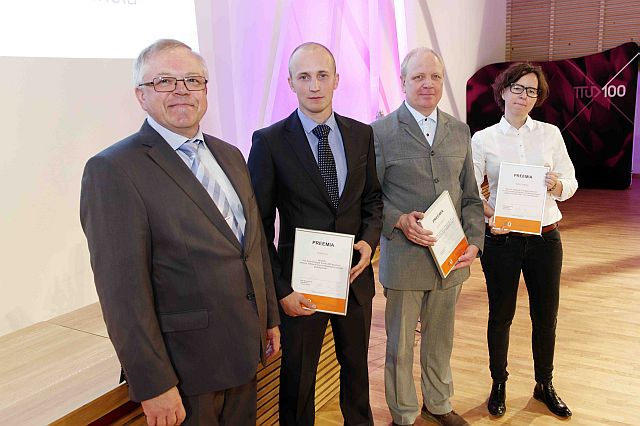
Raido Enn Bachelor’s dissertation in the University of Tartu programme Material Science “X-ray analysis of the hydration of Portland cement”
Supervisor: Senior research fellow at University of Tartu Institute of Physics Hugo Mändar, PhD
“Both dissertations that were awarded the prizes study the ingredients of concrete, being remarkable in terms of the high-tech development of Estonian cement and concrete industry,” said Tiit Roots, the chairman of the management board of the Concrete Association of Estonia. “Participation of the concrete industry in the recovery process of oil shale ash as a secondary raw material that is so important for Estonian national economy is also important,” Roots added.
Taavi Ilu`s Masters thesis "The suitability of AS Eesti Energia Enefit-280 fly ash in the concrete replacement of portland cement", co-supervisor Aare Lessuk, AS E-Betoonelement quality manager comments:
"From an environmental point of view, the important part is the decreasing amount of CO2 emitted into air in the production of concrete and the transfer of residues from the combustion of oil shale into recycling.
The fact that the fly ash used for experimental purposes in the final thesis is the result of newer technology-based combustion processes (fluid-bed-based technology) makes the topic even more relevant, which is why its features are different from the fly ash used in the construction industry (dust-fired technology). The properties and usability of such fly ash have not been studied extensively so far, so opening up the graduation work to new possibilities in the concrete industry, eventually reducing the cost of manufacturing concrete.
The main conclusion of the thesis is that the partial replacement of Portland cement with a fluid bed boiler ash is possible. The optimum result is the 10% replacement of cement with a fluid bed boiler ash, in which the compressive strength of the concrete remains at the same level as the Portland cement concrete. Research needs to be continued to be introduced into production. "
Jaak Kikas, Director of the Institute of Physics at the University of Tartu, professor: "The X-ray Analysis of Portland Cement Hydration" by Raido Enn, Bachelor's Thesis "Portland Cement Hydration X-Ray Analysis":
"In-situ XRD (X-ray diffraction analysis) method is one of the most important methods for investigating the hardening of cement and, as we know, there was no corresponding capacity and experience in Estonia. Therefore, it was decided to start the development and research of this method in the UT FI Cell Technology Laboratory.
As part of Raido Ennu's thesis, the design, construction and testing of the stonewall chamber was also part of.
The Estonian Concrete Association grants student awards starting in 2007.
The Estonian Concrete Association (founded in 2004) is an association promoting the use of concrete as a building material for domestic use, which includes 57 enterprises, organizations and private individuals.
Source: Press release from Estonian Concrete Association, In Nomine OÜ
E-Betoonelement and Kuressaare Ehitus have entered into a contract for designing the Haeska farm container and manufacturing, transporting and assembling elements.
Object: Haeska farm container
Address: Haeska Village, Pihtla Rural Municipality, Saare County
Customer: Kuressaare Ehitus AS
Contracting by AS E-Betoonelement: design, elements, transport and assembly
Project manager: Kaido Kindel
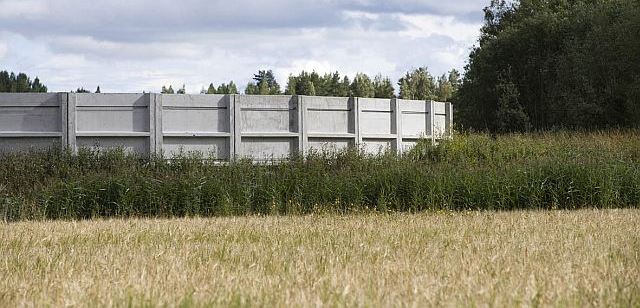
Project manager of E-Betoonelement Kaido Kindel: “In July and August of this year, we are installing another larger Acontank™ farm container with a capacity of 6,000 m3 in Saaremaa. We have installed this type of containers before in co-operation with Kuressaare Ehitus. Our co-operation is successful and has resulted in permanent and necessary buildings for farm owners for several decades to come.”
Acontank™ farm containers are long-lasting, practically maintenance-free and they are quick and easy to install, taking usually just one day. You can read more here: Lahendused/cabro/
This summer, E-Betoonelement will manufacture, deliver and assemble the elements for the extension of the already existing MetaPrint production and storage facility in Pärnu.
Object: Extension of MetaPrint
Address: Savi 14b, Pärnu county
Customer: Eston Ehitus AS
Contracting by AS E-Betoonelement: elements, transport and assembly
Project Manager: Toomas Böttcher
E-Betoonelement’s project manager Toomas Böttcher: “E-Betoonelement has previously manufactured three production sites for AS MetaPrint, two of those in Tallinn and one in Pärnu. The current project consists of expanding the Pärnu unit. Of products, we are delivering hollow core panels, posts and triple-layered wall elements to the site.”
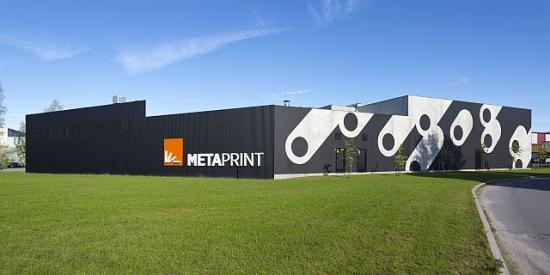
MetaPrint production and storage facilities are based on the Basic hall™ solution, which has several advantages such as quick set up time, security, less posts on the usable space inside the building, and good indoor climate both in the summer and in the winter.
The delivery and assembly work carried out by E-Betoonelement takes place in July of this year.
AS MetaPrint valmistab aerosoolpudeleid ja trükitud plekki.
E-Betoonelement is manufacturing elements for the development of the apartment building at Uus-Sadama St 11, which will be completed in cooperation with Fund Ehitus.
Project: Uus-Sadama 11, apartment building with commercial premises
Customer: Fund Ehitus
Architect: QP Arhitektid
Services: manufacture and transport of reinforced concrete elements
List of products: hollow core panels, posts, beams and wall elements
Project Manager at E-Betoonelement: Toomas Böttcher
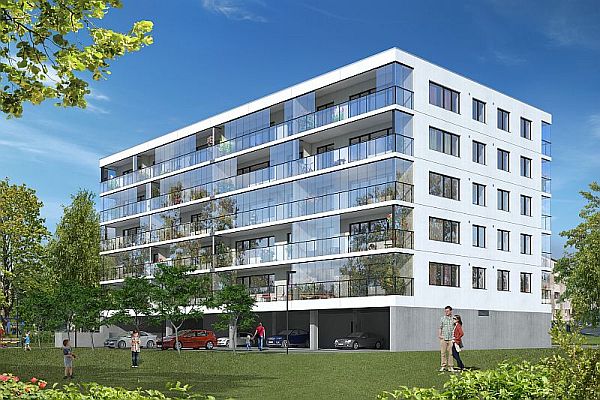
E-Betoonelement’s project manager Toomas Böttcher: “In addition to residential premises, commercial premises are also planned for the apartment building to be built at Uus-Sadama Street. Commercial premises situated on the ground floor will have a unique exterior finishing thanks to the Reckli’s surface pattern form liners.”
The building has been designed as a cuboid with clear forms, which is characteristic of apartment buildings in the vicinity of the area and blends into the urban space. The building is designed to have six aboveground storeys and one underground storey. Commercial premises and an open parking lot are situated on the ground floor. The higher floors of the building house apartments. The apartments are designed to have large balconies on the side of the building towards the courtyard and smaller balconies/loggias on the side towards the street, based on the principle that each apartment should have a separate outdoor area.
E-Betoonelement’s deliveries commence in June and will take place until the start of September of this year.
Next week on Wednesday and Thursday, E-Betoonelement is participating at the TUT student fair and conference BuildIT that is taking place at the Tallinn University of Technology for the fourth time already. It is a spirited two-day event aimed at students and youths interested in construction that provides an overview of what is taking place in the construction world.
Build-IT consists of a brilliantly expanding conference, a farewell show of useful contacts, a test day of competition, and educational workshops.
19 April – conference “Destruction and Renovation”
Talk about wisely recycling waste from scrapping and recycling options during the demolition work. About Estonia's progress in the field of renovation. Business representatives talk about recent demolition and renovation objects. The conference ends with a discussion circle in which specialists in their area will discuss the future of the districts of Tallinn. Vaido Leosk, Director of the E-Betoonelement, will participate in the final panel of the conference with Maira Derliš Linnalabor, Jarek Kurnitski TUT and Priit Luman Nordecon AS to discuss whether it would be worthwhile to renovate Soviet-era apartment buildings or build new ones instead?
You must register for participation at the conference.
The conference is in English.
Read more: http://2017.buildit-tallinn.eu/et/konverents/
20. aprill – mess - Tallinna Tehnikaülikooli aulas
Mess, where students have the opportunity to meet with different construction organizations and companies, communicate freely with them, and exchange contacts for potential internships and workplaces. For example, Saint-Gobain Ehitustooted AS, E-Betoonelement AS, Purustaja OÜ, the Student Council of the Faculty of Engineering and the Estonian Association of Civil Engineers are represented at the fair. Further information can be read here: http://2017.buildit-tallinn.eu/et/mess/
20. aprill - võistluspäev
All interested persons - both high school students, students and just construction enthusiasts - can participate in the competition day. Competitions require different skills and develop new ways of thinking, but are fun and entertaining. See more: http://2017.buildit-tallinn.eu/et/voistlus/
AS E-Betoonelement is participating at Maamess in Tartu on 20–22 April. As usual, we are exhibiting products of the agricultural division CABRO™: support walls, Acotank™ containers and Aconsilo™ silo solutions. What’s new is that we have included general construction – construction of buildings (pigsties, aviaries and barns) – in our exhibition booth, as constructing these is also topical for every keeper of animals.
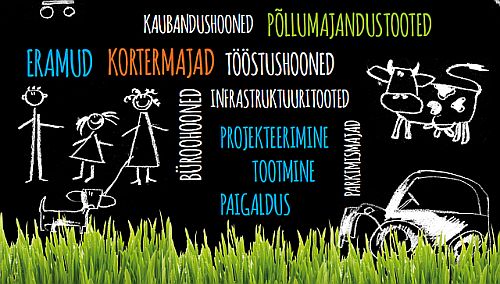
Maamess on Baltiriikide tunnustatuim maateemaline mess, mille eksponaadid laiuvad nii sise- kui välialadel ligemale 60 000 ruutmeetril. Mess toimub 25. korda.
The fair is open:
On Thursday, 20 April, at 10–18 (official opening at 12:00)
On Friday, 21 April, at 9–18
On Saturday, 22 April, at 9–16
E-Betoonelement is still located in Hall A!
See you at the fair!
Magazine Ehitaja, March
Detached house in Nõmme that used the technology of composite thermal bridge-free connectors unique in Estonia
Elemental construction has started to grow on the Estonian construction market and its volume is likely to grow even more. The advantages of flat-panel construction are lower cost, the speed of setting up the building, weather conditions independent, quality assured, as well as the technological development of the elemental manufacturers, which offers a wide range of architectural solutions.
Element construction also has to follow the increasingly stricter requirements of energy efficiency. The development of construction insulation has seen a major change all over the world. PIR insulation has found a firm place on the market thanks to its optimal cost and ease of use. External structures, including triple-layer external wall elements, have become thermal bridge-free, leaner and more durable in time, but the price of the structure has remained the same.
The technology of composite thermal bridge-free connectors that has already gained a foothold in Europe was first adopted in Estonia by OÜ Enerest in cooperation with E-Betoonelement in the construction of a detached house in Tallinn that was also nominated as the concrete building of the year.
The new technology enabled achieving a thermal transmittance of a triple-layer external wall of 0.09 W/m2K at a wall thickness of only 47 cm. At the same thickness, a traditional panel can only achieve a thermal transmittance of 0.15 W/m2K, i.e. only 60% of the potential thermal transmittance.
The insulation of the panel was based on IKO Enertherm's strong KRALU insulation board (24 cm) and cold-brush Thermomass STAR fiber bundles based on steel-bonded concrete layers. Thermomass bonds make it possible to save money at the expense of thermal insulation, because they do not have to take into account the effect of thermal bridges. Their installation through insulation is tight, providing the best quality.
Providing the same heat transfer through traditional technology would have meant a panel of at least 73 cm thick. The new technology therefore gives 26 cm of the interior win of the building from the same warmth. For example, today, the thermal transmittance of outdoor walls in Estonia is 0.15 W / m2K, the corresponding inner surface winning is 12 cm.
Given the economic aspect, perhaps simplified considering the construction price and the size of the area sold, technology becomes economically dubious if the investment exceeds ca 35 euros per wall meter.
Given that the price of panel elements is largely dictated by market demand and therefore the price scale is barely foreseeable, the use of more efficient thermal insulation and cold-free ties in the final price of the product is of little importance. However, for some buildings, 12-cm wide inner surface victory is a cost-effective initial investment for developers or home-builders.
THERMOMASS STAR composite material connector
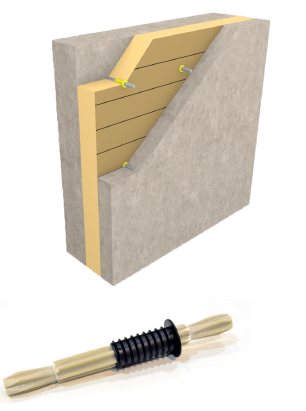
IKO Enertherm KR-ALU insulation board and THERMOMASS STAR connector
Magazine Ehitaja, March, Lauri Leet
One of the latest innovations of the concrete industry that is always looking to innovate is using titanium dioxide in concrete. The substance familiar from the chemical industry makes the surface of the concrete bright, self-cleaning and supposedly also more environmentally friendly, but it does increase the price by approximately 3%.
The use of titanium dioxide in the concrete industry has been around for over ten years. Different titanium dioxide is available in both liquid and solid form, and is mixed in concrete or in coated concrete elements. One of Europe's leading concrete product design and manufacturing groups, Consolis, has carried out quite extensive research on the use of titanium dioxide in both gray and white cements, and has been studying the self-cleaning ability of elements of titanium dioxide for nearly 10 years.
In Estonia, AS E-Betoonelement, which belongs to the Consol Group, has been manufacturing concrete products with titanium dioxide. Quality manager of the company's production Aare Lessuk notes that they has not been deepened into chemical process of titanium dioxide or its development, rather it is being dealt with it´s practical form with the production of titanium dioxide in concrete elements. The company has not separately studied the ability of nitrogen compounds of titanium dioxide nitrogen compounds to be airborne, and it does not want to think about it. The main advantage of the titanium oxide concrete elements is the controlled benefit of their self-cleaning effect.
In Estonia, concrete elements containing titanium dioxide have been manufactured by AS E-Betoonelement who is a member of the Consolis Group. According to the recollections of the company’s quality manager Aare Lessuk, E-Betoonelement actually started experimenting with titanium dioxide in 2012 out of interest. They manufactured grey concrete test specimens with a diameter of 100x100x30 mm where they mixed in titanium dioxide in different quantities. After curing, they drew lines on the test specimens with a waterproof marker and left them in the early summer sun when the UV level in the air is relatively high. “We manufactured the test specimens in May, and in June, a month later, a considerable purification could be noted,” Lessuk explains and brings out comparative photographs that provide clear evidence that the line drawn with a marker is noticeably lighter in the photos from June.
The fourth volume percentage does not affect the properties of the concrete
E-Betoonelement uses titanium dioxide only in powder form. In the production of concrete, weigh the necessary quantities and add titanium dioxide as the sands and aggregates are mixed dry manually to the mixture.
Titanium oxide should be added to 4% of the company's current experience. "A certain amount will provide a satisfactory effect. If the substance is to be dosed more, it will affect the compressive strength of the concrete negatively. If you follow the 4% rule, titanium dioxide does not have a significant negative effect on compression strength, "says Aare Lessuk.
Sales director of E-Betoonelement Aare Pärna confirms that there is a moderate interest in concrete elements with titanium dioxide, and a certain number of customers are also ordering them. The price difference is also noticeable, adding titanium dioxide will increase the price of the concrete product by about 3%. With the production of titanium dioxide, the entire process must be thoroughly considered. The production process must be clean, with the titanium dioxide starting the concrete planers must be washed beforehand, the mixers are to be lubricated with cleaning agents and the first cleaner mixer thrown away, Lessuk explains the high cost of the product. "If the customer asks for the product, then we obviously offer it in the best possible way, although its production may also be a challenge for us," both Pärna and Lessuk confirm.
Elements with titanium dioxide made up approximately 3% of the volume of concrete elements manufactured in the Harku plant last year by the company. E-Betoonelement received the first orders for the manufacture of concrete elements with titanium dioxide two or three years ago. They have manufactured facade elements for a couple of detached houses; the most famous site is the Karl Storz Video Endoscopy Estonia production, service and office building at Pärnu Highway near Tallinn that was included among the nominees of the Concrete Building of the Year 2016. Also for the construction of the buildings of the Defence Forces. Karl Storz Video Endoscopy Estonia tootmis-, teenindus- ja büroohoone Near Tallinn on the Pärnu highway. Titanium dioxide elements are also supplied to the Defense Forces Ämari and Jõhvi barracks, and these elements are currently being completed for the construction of Tapa barracks.
COMMENT
Architects of the Karl Storz building: we wanted beautiful concrete surfaces
"Aasta Betoonehitis 2016” nominentide hulka kuulunud Karl Storz Video Endoscopy Estonia tootmis-, teenindus- ja büroohoone fassaadielementide tootmisel kasutas E-Betoonelement titaandioksiidiga elemente. Hoone projekteerinud arhitektide, Arhitektuuribüroo Luhse & Tuhal OÜ arhitekt-tehnik Tõnu Oppi märgib, et eesmärk oli saavutada hele, naturaalse ilmega nägus betoonpind. „Soovisime kasutada tavalist halli betooni ning koostöös betoonitootjaga leidsime, et kõige õigem lahendus selleks on titaandioksiidi kasutamine.”
The facade of the building has been standing for about a year now and, according to Oppi, it may be noted that during this time the concrete surface has grown pleasantly and the building has become more attractive. "We believe that the use of titanium dioxide is the right choice for achieving better weather resistance and time-consuming, bright, pleasant surface concrete," Tõnu Oppi resizes.
WHAT IS WHAT
Titanium dioxide
Titanium dioxide is (subtle powder) a bright white, non-toxic, persistent solid which is mainly used as a pigment in paints and paper. When heated, it turns yellow, cooling white will return. In the light the matter substance becomes a semiconductor, which is why it is used to transform solar energy into electrical energy in solar cells.
The advantages of titanium dioxide concrete elements are their better resistance to weather conditions, self-cleaning of concrete surfaces and its brighter and lighter appearance. It has also been found that concrete walls treated with titanium dioxide clean the environment by binding nitrogen compounds from the air when exposed to UV radiation.